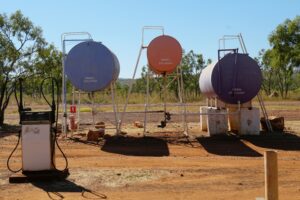
Artificial insemination (AI) is the placement of sperm into a female reproductive tract by other than natural means. The use of AI is a very cost effective way to speed up genetic improvement because it allows the use of superior male animals to be propagated very easily and quickly.
Cloning uses specialised DNA technology to produce multiple, exact copies of a single animal. The first calf was cloned in South Africa in 2003. It is envisaged that cloning will become a cost effective way to speed up genetic improvement as exact replicas of superior animals can be produced.
Embryo transfer is the process of removing embryos from a superior cow and placing them in a surrogate cow where they develop into a calf. Like AI, embryo transfer is a very cost effective way to speed up genetic improvement. In this instance the genetics of a superior female animal can be propagated.
In Genomics, hereditary characteristics are passed down through DNA, the “blueprint” of the organism. Genomics is a branch of genetics which deals specifically with the sequence of chemical bases in DNA. Genomics complements existing technologies like performance testing, and will accelerate genetic improvement.
Laparoscopic-assisted artificial insemination is when, simultaneously to AI, gas is inserted to assist insemination.
Performance recording entails the measuring of traits that affects the profitability of the animal and ultimately the breed. Different breeds measure different attributes based on what is considered important to that breed. Members of cattle breed societies usually measure attributes such as reproduction, growth, carcass and functional efficiency. Merino breeders would for example measure additional traits such as fibre diameter and fleece weight.
A Breeders’ Society may be formed if members of a particular breed wish to form such a society. The application forms can be obtained from the registrar at the Department of Agriculture, Land Reform and Rural Development (DALRRD). Breeders’ Societies exist for most breeds of animals. The objectives of most societies are to:
The Animal Improvement Act of 1998 allows societies to issue their own registration certificates if they so wish. These societies act as their own registering authorities. The SA Stud Book is a registration authority providing registration and secretarial services on behalf of many different breed societies. BREEDPLAN fulfils a similar function.
Registration certificates certify that an animal is a “stud” animal and is issued on behalf of the Breeders’ Society. These certificates are intended to be a guarantee that the animal has met certain requirements as laid down by the society and registering authority.
A list of registered Breeders’ Societies with their contact details is given under relevant headings later on this page. Lists may also be found at the following websites: https://studbook.co.za and www.lrf.co.za
When deciding on a breed, the following points are important:
Knowing about the relationship between individual animals (i.e. who the father is/was), AND performance measurements are vital for the genetic improvement of farm livestock. Classical pedigrees (which reflect only the name/number of an animal and its ancestor) have a limited value when it comes to livestock improvement. Modern pedigrees are:
These are indispensable for optimal genetic progress. A record is kept on these results.
Kaonafatso ya Dikgomo (KyD) is “a dedicated animal recording scheme for emerging/ smallholder farmers”. For general information, call the ARC at 012 672 9111.
The Directorate Animal Production at the Department of Agriculture, Land Reform and Rural Development (DALRRD) is responsible for the evaluation of new breeds and the regulation of the activities of breed societies and registration authorities. Application forms to register for the above can be found at www.dalrrd.gov.za. Regulations pertaining to Animal Improvement are published in the Animal Improvement Act, 1998 (Act 62 of 1998). The Act is administered by the Directorate.
The aim of the Directorate Farm Animal Genetic Resources is to “ensure the conservation and sustainable use of farm animal genetic resources (FAnGR) for food and agriculture”. Find its pages at www.dalrrd.gov.za.
Further reference:
Software Programmes
Exporting/Importing
Training and research
Breeds include Chester White, Duroc, Large Black, Large White, Hampshire, QM Hamline, Pietran, Robuster, SA Landrace, Welsh. Contact the Pig Breeders Society of South Africa. Find further information at www.pigsa.co.za and https://studbook.co.za.
Visit the websites listed earlier on this page.
